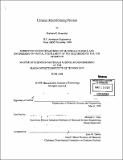Ceramic microforming process
Author(s)
Rosenthal, Matthew E. (Matthew Eric), 1971-
DownloadFull printable version (48.75Mb)
Other Contributors
Massachusetts Institute of Technology. Dept. of Materials Science and Engineering.
Advisor
Michael J. Cima.
Terms of use
Metadata
Show full item recordAbstract
A forming process for creating MEMS and mesoscale ceramic parts with micron scale features has been developed. This micromolding process takes advantage of clean room compatible techniques to create silicon etchings, which are used to create a silicone transfer mold. The silicone molds are used to make numerous sacrificial mold into which ceramic slurry is cast. The wax molds are sacrificed leaving green ceramic parts which are fired to produce the final component. The process was found to reproduce features as small as 2 gm with a tolerance of ± 0.8 pm over about a 100 pm length scale. The production of several parts are examined, demonstrating the ability to make stand alone MEMS and mesoscale parts with complex geometries. A non-ceramic application involving precise particle arrangement is also discussed. Observations regarding part quality, defect formation, yield issues, and process enhancement are made, along with a characterization of the dimensional stability of the process. The costs associated with processing silicon molds are also compared to competing processing techniques. This technique has generated excellent results and has potential to become a major forming tool to fill the materials selection gap in MEMS and mesoscale component design.
Description
Thesis (S.M.)--Massachusetts Institute of Technology, Dept. of Materials Science and Engineering, 1998. Includes bibliographical references (leaves 110-113).
Date issued
1998Department
Massachusetts Institute of Technology. Department of Materials Science and EngineeringPublisher
Massachusetts Institute of Technology
Keywords
Materials Science and Engineering.